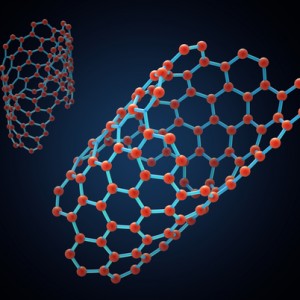Biomarkers Reveal Mechanisms Behind Carbon Nanotube Toxicity, Fibrotic Effects on Lungs
Written by |

 Nanomaterials continue to gain in popularity in technological, biomedical, and many other applications, but their defining small size may pose a significant threat to lung health. Scientists have been concerned with the potential pulmonary toxicity of multi-walled carbon nanotubes (MWCNT) in the context of industrial settings, Back in October, Pulmonary Fibrosis News reported on how researchers had noted lung injury from carbon nanotubes was indeed a reality, and that the risk factor may be reduced by designing them using an aluminum coating. Now, a new study from West Virginia University and the National Institute for Occupational Safety and Health shows that genetic material can be used as biomarkers to predict the presence of MWCNT-induced lung inflammation.
Nanomaterials continue to gain in popularity in technological, biomedical, and many other applications, but their defining small size may pose a significant threat to lung health. Scientists have been concerned with the potential pulmonary toxicity of multi-walled carbon nanotubes (MWCNT) in the context of industrial settings, Back in October, Pulmonary Fibrosis News reported on how researchers had noted lung injury from carbon nanotubes was indeed a reality, and that the risk factor may be reduced by designing them using an aluminum coating. Now, a new study from West Virginia University and the National Institute for Occupational Safety and Health shows that genetic material can be used as biomarkers to predict the presence of MWCNT-induced lung inflammation.
Writing in “mRNA and miRNA Regulatory Networks Reflective of Multi-Walled Carbon Nanotube-Induced Lung Inflammatory and Fibrotic Pathologies in Mice,” lead author Dr. Julian Dymacek described the team’s investigation into the regulatory networks of mRNA and miRNA signaling pathways activated in response to MWCNT. To gather data, the team exposed mice to various concentrations of MWCNTs and collected lung tissue samples from the mice for up to 56 days after exposure.
Lung tissue samples were analyzed for mRNA and miRNA expression profiles to determine any pathology-related changes in expression compared to gene profiles of unexposed mice. Multiple databases suggested binding targets for mRNA and miRNA, and these targets were used to construct molecular signaling networks that are up-regulated by MWCNTs.
[adrotate group=”3″]
Overall, the team found 134 genes functionally involved in inflammation and another 89 genes involved in fibrosis. Looking at patterns among the genes, the researchers determined that the regulatory networks were related to the inflammatory response and tissue remodeling biological processes. Evidently, exposure to MWCNTs caused pulmonary inflammation and fibrosis in the mice.
Other researchers have likened MWCNTs to asbestos fibers due to structural similarities and have demonstrated MWCNT-induced cases of lung damage, which is concerning due to the poor clinical outcome of pulmonary fibrosis. Using results from the present study, it may be possible to test for biomarkers that indicate the presence of underlying pulmonary inflammation as a result of exposure to MWCNTs. “These identified genes and pathways may be useful for determining biomarkers of MWCNT-induced lung inflammation and fibrosis for early detection of disease,” wrote Dr. Dymacek.






